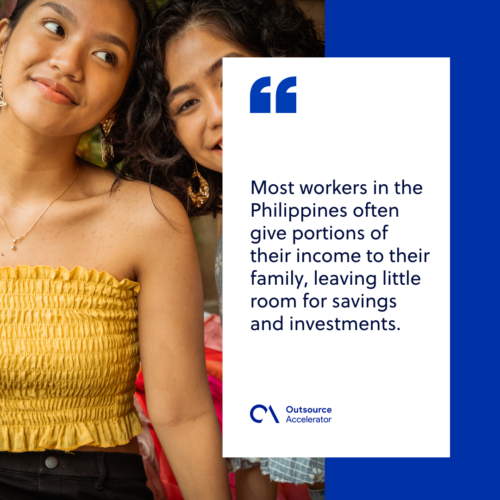The Philippines and the Filipino workers’ salary

The Philippines is a melting pot of cultures, ethnicities, the old, and the young. Companies, both local and international, capitalize on this. The Philippines’ salary may be too low compared to its western counterparts, but most Filipinos can survive on these wages.
With a lot of professionals in the field, it’s not a surprise that some Filipinos earn more or less than their counterparts. Some industries and businesses pay better salaries than others too.
So how can a person—single and unmarried or with family—survive Manila with its wages? That’s the question we’d like to explore today.
Average Philippine salary in 2022
The average Philippines’ salary is ₱15,200, according to Picodi. While it sounds too low, many Filipinos started out with this salary. Most people used this as a starting point to catapult themselves into higher compensation brackets.
But there’s a different story behind each worker’s salary.
In the Philippine industry, “contractualization” exists. This refers to a contract worker that is mandated to render services over a predetermined time. Contracts usually renew every six months, unless the company expresses immediate termination of the contract.
More often than not, contract workers receive benefits like regular employees. But there are some cases where organizations keep their employees on contracts to avoid paying benefits.

How ₱25,000 can support a Filipino
If you identify as single, you may just survive with ₱25,000 in your pocket every month. In the Philippines, salary grades like that can go a long way if you know how to work it out.
Rent, utilities, food, supplies, and bills have their own way of sneaking up on you. Not to mention, emergencies are as inevitable as taxes.
Spending wisely and tracking your budget religiously is the first step of becoming financially literate. But what happens to the ₱25,000 when you have a family to feed?
For instance, say that you’re living in a single-income household. You are earning ₱25,000-30,000 in Philippine peso (roughly US$500-600) every month. The bills and expenses are labeled the same and yet you may find it difficult to allocate enough to cover them completely.
However, living on $500 a month is doable—it can allow you to survive in a modest and decent standard of living.
The cost of living in Metro Manila
Depending on where in Metro Manila you are, you may find that rent won’t take up 30% of your monthly salary. And yet, there are certain places in central business districts (CBD) that would make it harder for you to budget your income.
For an average Filipino worker, their expenses may come up to ₱20,000-25,000 a month, including everything but savings.
For an upper-middle-class Filipino or an expatriate, their way of living is higher and more luxurious than their average counterpart.
Why Metro Manila is considered expensive
With sprawling CBDs and infrastructures of leisure and work, we consider Metro Manila as the center of everything. In various ways, convenience comes with a price.
Rent prices in the cities of Makati, Taguig, and Manila are continuously ramping up, especially if you’re getting closer to the center of it all.
Living in central business districts
We know CBDs for their towering buildings, sprawling grounds for leisure and after-work activities, and living spaces for professionals and families.
This kind of convenience—living close to everything you might ever need—comes with a price.
We usually divide salary portions into rent, utilities, bills, and supplies. If your field of work allows you to be more flexible in terms of financial matters, be sure to put it into good use.
Provincial rates and minimum wages
Most workers in the Philippines often give portions of their income to their family, leaving little room for savings and investments.
Some of them live in the city in boarding houses and lodgings to save on commuting expenses. And while that’s manageable, they still need to shell out money to sustain daily life.
The minimum salary in the Philippines is ₱316 (US$6.57) to ₱537 (US$11.17) a day, according to ASEAN Briefing.

Stretching out your salary
Whether you’re new to the industry or an experienced employee, you might still need to stretch out your paycheck from the first cut-off to the second one.
Budgeting
Tracking your budget via a personal spreadsheet or a budget tracking app will help you see your expenses and income in real time.
The paper envelope method
Label envelopes with words such as “rent,” “utilities,” “food,” “savings,” and “petty cash” to help you manage your expenses within that month.
Paying yourself first
Pay yourself first by tackling necessities out of the way. Savings, investments, and emergency funds can be held until the last part of budgeting.
But keep in mind that this method may not work for everyone—find what works for you.
Emergency funding
Emergency funding (EF) is as simple as its name suggests. It’s composed of at least six months’ worth of expenses, enough to cover you up in case something happens.
Most people don’t have EF, and that’s okay. Though living paycheck to paycheck can be hard, some people don’t have a choice.
Wants vs. needs: Living with the Philippines’ salary
₱15,200 may be too low as the average salary in the Philippines, but it is a fact that many people are able to get by, albeit with very close-fisted measures. There is often very little to none left for luxuries.
What we can take away from them is that it is vital to differentiate between wants and needs. If you start with a small salary, identifying your needs is key to maintaining good budget management.







 Independent
Independent




